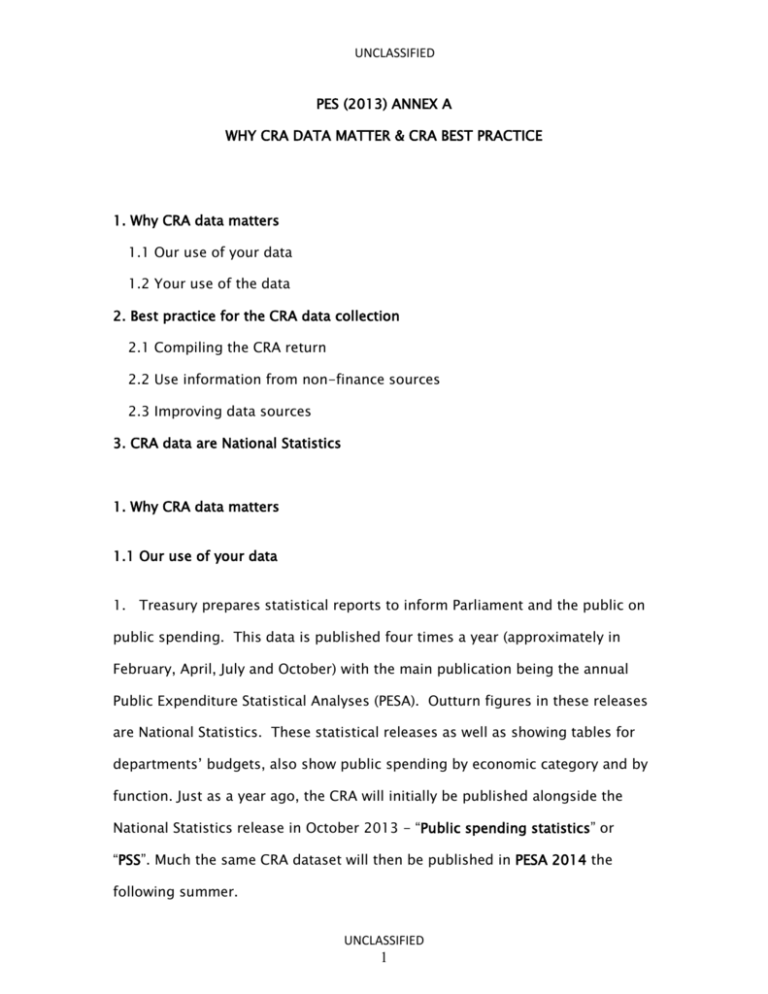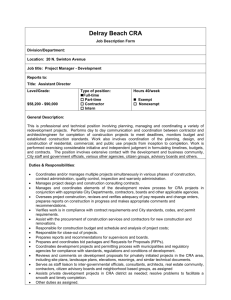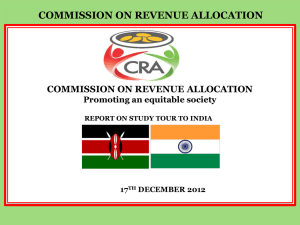Annex A: Why CRA data matter and CRA best practice
advertisement

UNCLASSIFIED PES (2013) ANNEX A WHY CRA DATA MATTER & CRA BEST PRACTICE 1. Why CRA data matters 1.1 Our use of your data 1.2 Your use of the data 2. Best practice for the CRA data collection 2.1 Compiling the CRA return 2.2 Use information from non-finance sources 2.3 Improving data sources 3. CRA data are National Statistics 1. Why CRA data matters 1.1 Our use of your data 1. Treasury prepares statistical reports to inform Parliament and the public on public spending. This data is published four times a year (approximately in February, April, July and October) with the main publication being the annual Public Expenditure Statistical Analyses (PESA). Outturn figures in these releases are National Statistics. These statistical releases as well as showing tables for departments’ budgets, also show public spending by economic category and by function. Just as a year ago, the CRA will initially be published alongside the National Statistics release in October 2013 - “Public spending statistics” or “PSS”. Much the same CRA dataset will then be published in PESA 2014 the following summer. UNCLASSIFIED 1 UNCLASSIFIED 2. The CRA database is widely publicised and receives significant public, governmental and media attention every year. In addition, the CRA: Constitutes the main source of consistent regional data; Provides data for the Local Spending Reports produced under the Sustainable Communities Act 2007; and Can be used as a tool to measure the impact of regional policy. 1.2 Your use of the data 3. We are grateful to departments for incurring the, sometimes significant, costs of completing the CRA exercise. We encourage departments to make full use of this information to ensure maximum benefit is obtained from this work. 4. CRA data can help inform your internal planning processes and ensure your department’s spending effectively supports your policy objectives. Questions that your department might want to use CRA data to help answer, include: Are you satisfied that the regional distribution of your spending is fair? Do your regional spending plans support balanced economic development? Do you understand why spending per head is higher in some regions than others? Does this higher spending produce better outputs and outcomes? 5. Many departments also publish CRA data in their Departmental Reports as part of the common core tables, which could lead to Parliamentary and press interest. You will wish to ensure that those who need to brief on the figures are aware how they are compiled and that they understand the data. 2. Best practice for the CRA data collection 6. Preparing for the CRA exercise UNCLASSIFIED 2 UNCLASSIFIED Appoint a senior manager to be in charge of data compilation, and to oversee the return of the final CRA data. 7. Ensure that the Statistics Head of Profession (HoP) is aware of their role in the quality assurance process of the final CRA return. We ask that HoPs, or HoP delegates, submit a completed form accompanying the CRA return to: confirm they are content that the outturn data has been produced to National Statistics standards in accordance with the guidance described in Annex B; and comment on the process and methodologies involved in producing the figures, and identify any weaknesses in the allocation methods. We publish a statement on the quality of CRA data in PESA. In order to do this it is helpful if they, or another senior statistician, are involved in the process. 8. Ensure that communication takes place at a senior level within the department, so that awareness of the exercise goes beyond those staff that are directly involved with data compilation for the CRA return, and includes: those involved in the department’s various regional policy interests; and those aware of detailed accounting data (which may record actual regional spending data). 9. Involve departmental statistical staff, they may be able to advise on methods and use other relevant data sources, where directly measured data is not available. UNCLASSIFIED 3 UNCLASSIFIED 10. Read the Treasury’s guidance and consider how this applies to your data. 2.1 Compiling the CRA return 11. Involve others – don’t confine the exercise to the central finance team. For larger departments, or where departmental spending is spread over a substantial number of sub-programmes, co-ordinate the CRA return centrally, but delegate completion down to programme managers and those staff with the best overview of what regional data exists, including NDPBs and regional offices if necessary; Where grants go to NDPBs for distribution to private sector recipients, ask the NDPBs to allocate their spending by residence of recipient, or else provide information that will enable this to be done; and Ensure that those downstream asked to provide returns (programme managers, NDPBs, etc) understand what is being asked of them, and have the information and guidance they need to do their allocations properly. 2.2 Use information from non-finance sources 12. Consider what relevant data could be used for the different parts of each CRA segment. Use data from other sources besides departmental central finance. Example: Department of Health. Data is extracted from Primary Care Trusts' accounting system on the geographical location of patients treated. UNCLASSIFIED 4 UNCLASSIFIED 13. Where allocation of spending is formula driven, use those formulae as the basis for estimating a regional breakdown if directly measured data is not available. 14. Where directly measured data is not available, use an indicator appropriate to that type of spending. However, don’t automatically use the obvious ones like population or GDP proportions - they are unlikely to be appropriate for any spending that has been classed as identifiable by region. 15. Where central government provides central services in support of local authority spending (e.g. schools education) consider using local authority spending data as an indicator. 2.3 Improving data sources 16. In departmental accounting systems, recording some information on where spending takes place as a matter of course is best practice. Example: The Forestry Commission. They have unique regional codes on their ledgers. 17. For transfer payments (current grants, subsidies, capital grants), collect data on postcode of recipients. Where grants are paid out by NDPBs, encourage NDPBs to collect postcode data for recipients. 18. Where payments go through a ‘head office’ of some kind, ask ‘head office’ recipients for location information on the final recipients. Example: DEFRA (Rural Payment Agency). Direct payments under CAP are based on postcodes per region. In preparing the Treasury return, the Rural Payment UNCLASSIFIED 5 UNCLASSIFIED Agency get their technicians to sort all payments by postcode, and allocate them to regions. UNCLASSIFIED 6 UNCLASSIFIED 3. CRA data are National Statistics 19. The outturn CRA data that you hold and supply are covered by the National Statistics protocols. 20. We accept that departments’ aggregate expenditure data normally originate in their own accounting systems, and that this data is not covered by National Statistics protocols. Therefore, access to this data both for internal and external (e.g. Main Estimates) purposes does not need to be restricted. 21. However, the accounting data will normally have been statistically processed in order to generate the regional split of numbers. Since the CRA outturn data published in the PSS or in PESA are published as National Statistics, it follows that the underlying departmental data showing a regional split should also be seen as National Statistics. 22. The implication of treatment as National Statistics is that access restrictions to the regional data should apply in accordance with the Code of Practice for Official Statistics until publication of the PSS. In particular: Data should not be released into the public domain until PSS has been published. The CRA is first published in October as part of the PSS release. Once PSS has been published, no further access restrictions need be observed on grounds of National Statistics, even though the Departmental Report core tables will not yet have been published; and UNCLASSIFIED 7 UNCLASSIFIED 23. Please note, however, that CRA data, and associated briefing may be provided to Ministers and special advisors up to 24 hours in advance of the PSS publication for briefing purposes. 24. The exceptions to treating CRA data fully as National Statistics are where the country and regional data that the department provide are actually held on a country and regional basis for operational reasons. In that case, the normal partial derogations from the National Statistics protocols for management information apply where people need to have access to data in the course of their normal work. 25. Please contact Mohammad Huq with any queries you have on this National Statistics guidance. UNCLASSIFIED 8






